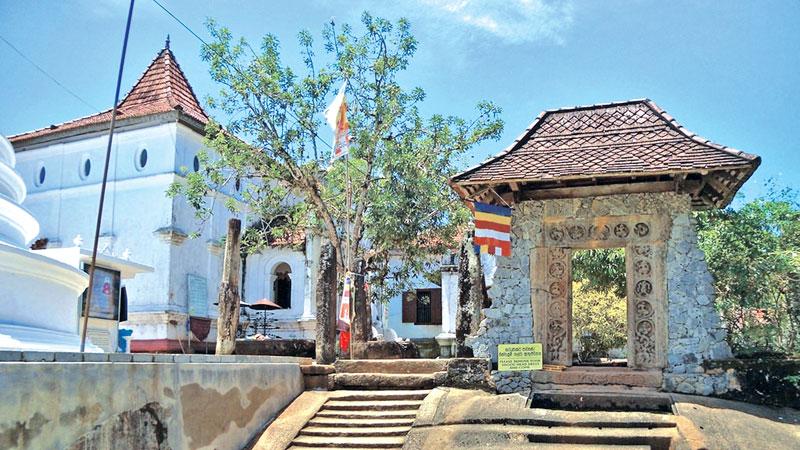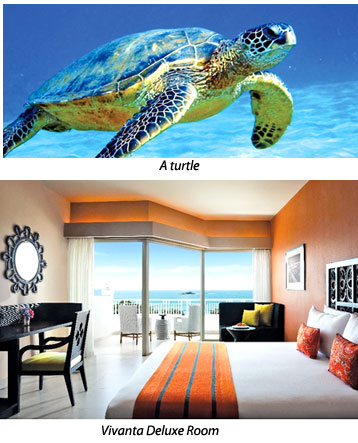
Our island is blessed with many pristine beaches. Perhaps, one of the best coastal areas is Bentota, which many opine was the first tourist destination in the South West coast. It is a land where the Bundara ganga (river) joyfully flows into the ocean.
I set off on a Monday morning as the traffic was slowly increasing on Galle Road. Shortly, we passed Wadduwa and then Kalutara. I observed many ancient temples, churches and mosques which is a radiant endorsement of diverse communities living in our motherland. As we near Bentota the coconut trees seem to bend towards the beach. I noticed a toddy tapper cautiously making his descent with a clay pot firmly attached to his waist. An old man beckons on the roadside selling king coconuts. Bentota town is busy, just like any other, as tourists of many nations walk about.
 The car pulls into the driveway of the Vivanta by Taj. The hotel lobby is beautifully invaded by the morning sun. My eyes are instantly diverted to a lovely pond laden with fish which is below lobby level. The area is akin to a miniature rainforest with cascading creepers and exotic palms, a refreshing contrast to the beach. My spacious room on level six captures perhaps the best ocean view I have witnessed in my travels. The bedroom redefines luxurious comfort.
The car pulls into the driveway of the Vivanta by Taj. The hotel lobby is beautifully invaded by the morning sun. My eyes are instantly diverted to a lovely pond laden with fish which is below lobby level. The area is akin to a miniature rainforest with cascading creepers and exotic palms, a refreshing contrast to the beach. My spacious room on level six captures perhaps the best ocean view I have witnessed in my travels. The bedroom redefines luxurious comfort.
In a few minutes, I meet a resident of the village, Wilson, who will be my travel companion for the day. Wilson has been in the local tourist industry for almost three decades, and he knows everything about Bentota. We start our tour in his red ‘tuk tuk’. We pass many lovely Walauwa style homes with large verandahs. I was disappointed that some have not been maintained. These brilliant abodes were once home to many wealthy clans. The area also has paddy fields. Our first stop is the famous Buddhist temple: Galapatha Vihara.
This is one of the three important temples in the growth of Buddhism in ancient Ceylon. The sanctum in fact has two temples. On the right is a placid patch of water complete with hundreds of lotus flowers, that enriches the serenity of the area. As we mount the few steps Wilson points to a rock formation protected by an iron fence. I was surprised to find an ancient rock inscription which tells the history of the acquisition of the land and administrator of the temple in the period 12 AD, during the reign of the majestic monarch, Parakramabahu 1. The land was apparently donated. The administrator was one Kahambaikulu Mindaina. I met one of the senior abbots Ven. Dhenagam Dhammasiri who very kindly spent half an hour showing me the splendour of the Vihara. It is from Galapatha Vihara that four other temples were built around this area. They are, Bodhimaluwa Vihara, Wanawase Raja maha vihara, Gane Raja maha vihara and Udakotuwa Bodhi sameepa Raja maha vihara. It is said, during the reign of King Devanampiyatissa there were eight schools of learning, and one was at this Vihara where monks were fluent in Pali, Sanskrit and Sinhalese.
The monk shows me the inner sanctums of the two temples, embellished with intricate drawings and large murals on some pillars. He pointed out a unique feature; high on the ornate ceiling was an image of King Edward. It remains a mystery as to why this was painted. During 1568 the defiant Portuguese raided and destroyed much of the temple. The resilient people and monks rebuilt the temple.
We bid farewell and proceed to another, known as Karijja Wella. On the way Wilson points out the Dedduwa Lake with its turquoise blue waters, where a few catamarans are passing. Its fresh water brings many villagers to frolic and play. We pass a stretch of road from where one can faintly see ‘punchi siripada’ a rock also known as Pahura Kande. The road from Karijja Wella is slightly muddy, yet, leads to a landing where a ferry operates. The next village is Hakurugala. Men and women await the ferry, some seated on their bicycles. The ferry arrives in a few minutes. The young ferryman grins at me displaying betel stained teeth.
We hit the road once more in search of Wanawase Raja Vihara. The temple is built on an elevated rock formation. One has to climb 42 steps to reach the top. Around the topmost part is a small garden. I noticed an opening in the ground shielded by a white cement barrier. It was later that I realized that below me was a tunnel network that went back all the way to Galapatha Vihara. Wow, how cool is that. I could only imagine the young monks walking underground with oil lamps in their hands. Today, the access way remains blocked.
I return to the hotel for lunch. Chef Neeraj has turned out some fine cuisine. As I savour the minted prawns Chef tells me tales of his diving adventures around Sri Lanka. Bentota is also famous for its turtle hatcheries. The baby turtles are cute as they swim in formation inside large pools. The green turtles are common and can weigh almost 250Kg.
The hawksbill turtle is beautiful with its shell depicting 13 symmetrical pieces.
The large leather neck turtle can weigh almost 700Kg, and is very rare. You can also venture out to be captivated by the gardens of Brief Bungalow, the plush estate of the late Major Bevis Bawa, the brother of the creative architect Geoffrey Bawa. The bungalow in its golden days had many foreign guests including, British crime novelist Agatha Christie!
The beach is quiet in the evening. The evening sunset paints the sky in hues of fiery orange red with streaks of purple. The colours reflect gently on the white walls of the hotel. I end the long day with a succulent seafood dinner. Channa Ekanayake sits down with me for a chat at the Morocco styled lounge at Vivanta where we enjoy some Turkish coffee.
Bentota is a paradise where you can truly escape the frenzy of the city and capture the essence of the relentless southern waves.
